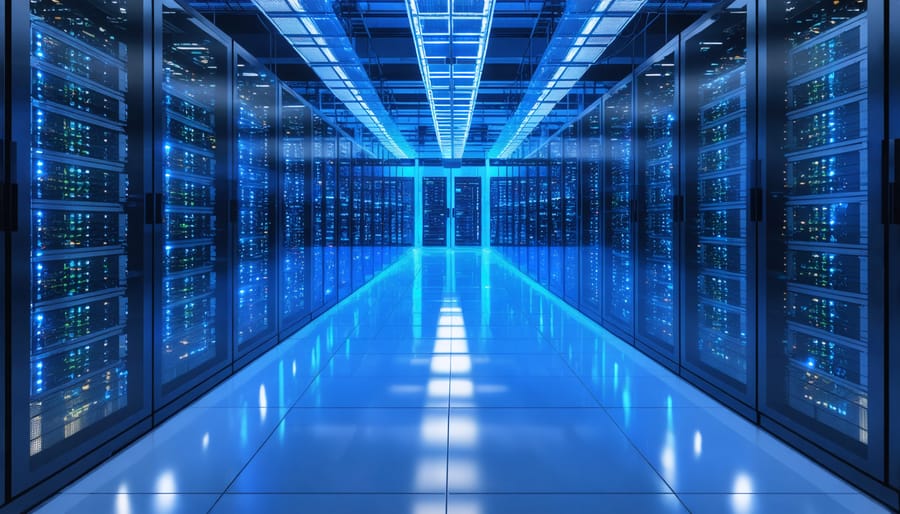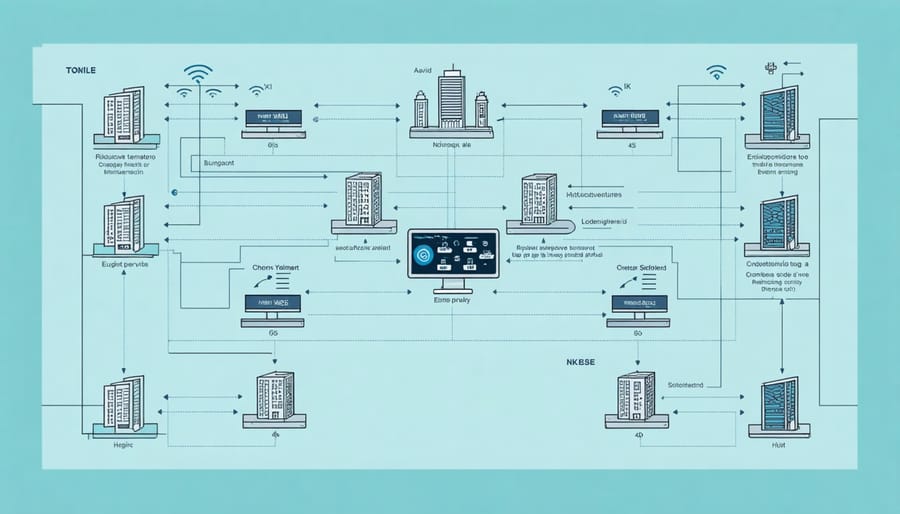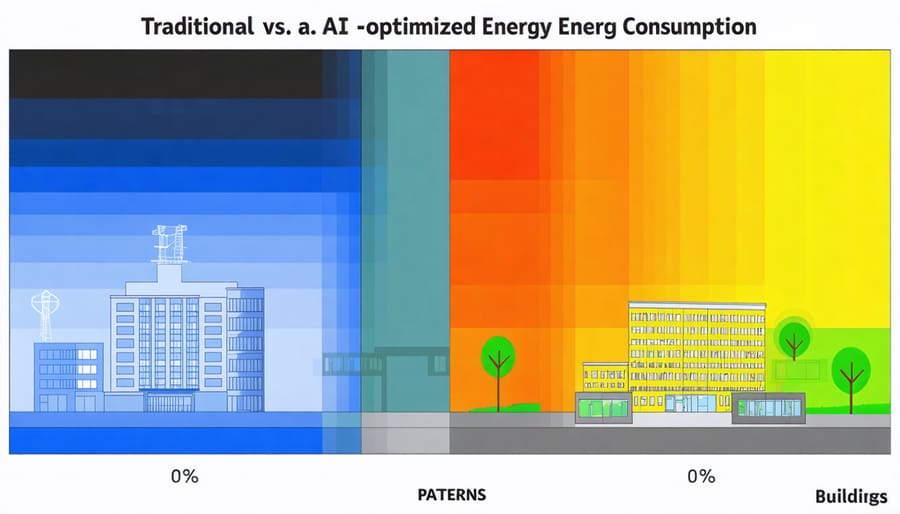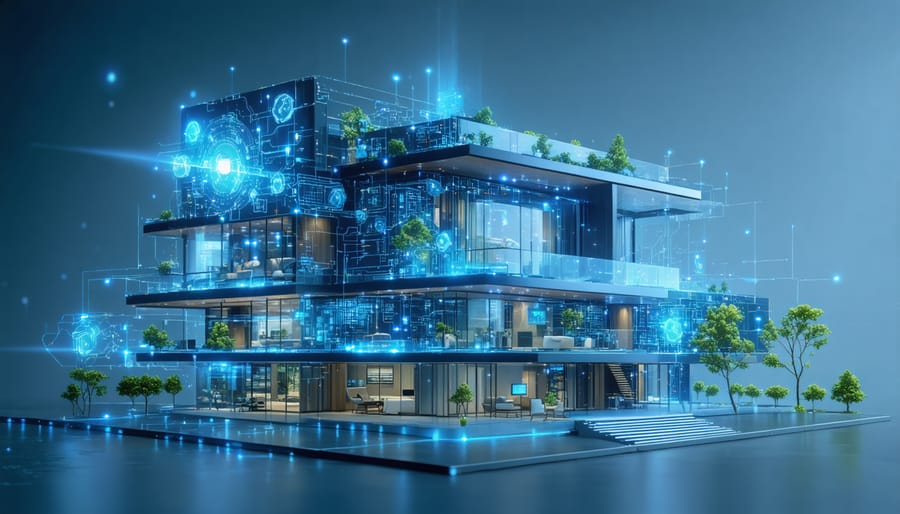Artificial Intelligence’s exponential growth brings an often-overlooked challenge: its massive energy footprint. As AI-powered building systems become increasingly prevalent in modern construction, the industry faces a critical paradox. While AI solutions optimize energy consumption in buildings, training these systems demands substantial power resources, sometimes equivalent to the lifetime emissions of five average American cars.
For construction professionals and facility managers, this presents both challenges and opportunities. The computing infrastructure required to run advanced AI models consumes megawatts of power, demanding innovative cooling solutions and enhanced electrical systems. Yet, when properly implemented, these same AI systems can reduce a building’s overall energy consumption by 20-30% through predictive maintenance, smart HVAC control, and real-time load balancing.
Understanding this balance is crucial for industry decision-makers planning next-generation building infrastructure. The key lies in implementing AI solutions that maximize operational efficiency while minimizing their own energy footprint through strategic deployment and advanced hardware optimization techniques.
The Real Energy Footprint of AI Systems
Data Center Requirements
Modern AI data centers require substantial power infrastructure to support their intensive computational demands. These facilities typically consume between 20-50 megawatts of power, with larger installations exceeding 100 megawatts. The power requirements stem primarily from two critical components: the computing hardware and the cooling systems necessary to maintain optimal operating temperatures.
The computing infrastructure consists of densely packed servers and specialized AI accelerators, such as GPUs and TPUs, which can draw up to 400 watts per processing unit. A typical AI training cluster might contain thousands of these units, resulting in significant power density requirements of 8-15 kW per rack, far exceeding traditional data center specifications.
Cooling systems account for approximately 40% of the total energy consumption in AI data centers. These facilities require sophisticated cooling solutions, including direct liquid cooling and rear-door heat exchangers, to manage the intense heat generated by AI workloads. The Power Usage Effectiveness (PUE) ratio for AI-focused data centers typically ranges from 1.2 to 1.5, reflecting the additional overhead required for thermal management.
Infrastructure requirements extend beyond just power delivery. AI data centers need robust electrical distribution systems, redundant power supplies, and uninterruptible power systems (UPS) rated for the increased loads. The electrical infrastructure must also accommodate high-density power distribution units (PDUs) capable of delivering up to 400 amps per rack to support the intensive computational workloads.

Training vs. Deployment Costs
The energy consumption patterns of AI systems reveal a stark contrast between training and deployment phases. During the training phase, when models learn from vast datasets, energy consumption reaches its peak due to intensive computational requirements. For instance, training a large language model can consume as much energy as 126 homes use in a year, primarily due to the multiple iterations required for optimization.
However, once deployed, AI models generally require significantly less energy to operate. Operational energy costs typically range from 5-15% of the initial training energy consumption, depending on the model’s complexity and usage frequency. This difference becomes particularly relevant for construction professionals implementing AI solutions in building management systems.
Recent case studies from commercial buildings demonstrate this disparity. A smart HVAC optimization system showed initial training costs of approximately 2,000 kWh but maintained operational efficiency at just 100 kWh per month. This represents an 83% reduction in energy consumption during the deployment phase.
To optimize energy efficiency, industry professionals should consider:
– Utilizing pre-trained models when possible
– Implementing efficient model compression techniques
– Scheduling intensive training during off-peak energy hours
– Deploying models on energy-efficient hardware
– Regular monitoring of operational energy consumption
Understanding this cost distribution helps construction professionals make informed decisions about AI implementation while maintaining sustainable building operations.
Optimizing AI Energy Efficiency in Building Systems
Smart Architecture Integration
The integration of AI systems into building architecture requires careful consideration of both computational requirements and energy efficiency. Successful implementation begins with a strategic placement of AI processing units, utilizing dedicated server rooms with optimized cooling systems and power distribution networks. Modern smart building technologies are increasingly incorporating edge computing solutions, which reduce transmission losses and optimize processing efficiency by positioning AI components closer to data collection points.
Key architectural considerations include the implementation of modular power systems that can scale according to AI processing demands, coupled with advanced thermal management solutions. Leading architects are now designing buildings with dedicated vertical shafts for AI infrastructure, incorporating natural cooling channels and heat recovery systems that can repurpose excess computational heat for building services.
Energy-efficient AI implementation also demands sophisticated power monitoring systems and automated load balancing capabilities. By integrating AI processors with renewable energy sources and energy storage systems, buildings can optimize power consumption during peak processing periods. This approach requires careful coordination between mechanical, electrical, and plumbing (MEP) systems to ensure seamless operation while maintaining optimal energy efficiency.
Recent case studies demonstrate that buildings designed with AI-specific architectural considerations can achieve up to 30% reduction in AI-related energy consumption compared to retrofitted solutions, highlighting the importance of early-stage integration in the design process.
Edge Computing Solutions
Edge computing represents a transformative approach to reducing AI’s energy footprint by processing data closer to its source, minimizing the need for constant data transmission to distant data centers. By integrating edge computing with IoT energy management systems, building operators can achieve significant energy savings while maintaining AI system performance.
Recent case studies demonstrate that edge computing can reduce AI-related energy consumption by 30-40% compared to traditional cloud-based processing. This efficiency gain stems from three key factors: reduced data transmission overhead, optimized local processing, and decreased cooling requirements for centralized data centers.
In practical applications, edge computing enables real-time AI processing for building systems like occupancy detection, HVAC optimization, and security monitoring without the latency and energy costs associated with cloud computing. For example, a commercial office building in Singapore implemented edge-based AI processing for its environmental controls, resulting in a 25% reduction in overall energy consumption while improving system response times by 60%.
Construction professionals should consider edge computing infrastructure during the initial design phase of smart buildings. This includes planning for distributed processing nodes, implementing robust local networks, and ensuring adequate power distribution for edge devices. The initial investment in edge computing infrastructure typically yields returns through reduced operational costs and enhanced building performance.

Sustainable Computing Practices
To minimize AI systems’ environmental impact, organizations should implement several key sustainable computing practices. First, optimize data center infrastructure by employing advanced cooling systems and utilizing renewable energy sources. Leading construction firms have demonstrated that implementing hot-aisle containment and precision cooling can reduce energy consumption by up to 30%.
Hardware selection plays a crucial role in sustainability. Choose energy-efficient processors and accelerators specifically designed for AI workloads. Modern GPUs with dynamic power management capabilities can significantly reduce power consumption during periods of lower computational demand.
Implement workload scheduling strategies that align processing tasks with periods of renewable energy availability. This approach, known as “carbon-aware computing,” can reduce the carbon footprint of AI operations by up to 45% according to recent industry studies.
Consider edge computing solutions where appropriate, as processing data closer to its source can reduce network transfer energy costs. Construction sites utilizing edge AI for real-time monitoring have reported 20-25% reductions in overall energy consumption compared to cloud-only solutions.
Regular monitoring and optimization of AI models is essential. Employ model compression techniques, quantization, and pruning to reduce computational requirements without sacrificing performance. Document successful optimization strategies and share best practices across teams to establish a culture of sustainable AI deployment.
Lastly, implement comprehensive energy monitoring systems to track consumption patterns and identify opportunities for improvement. This data-driven approach enables continuous optimization of AI infrastructure and ensures long-term sustainability goals are met.
Future-Proofing AI Infrastructure
Emerging Technologies
Several groundbreaking technologies are emerging to address AI’s energy consumption challenges. Quantum computing shows particular promise, with researchers demonstrating up to 90% energy reduction compared to traditional computing methods for specific AI workloads. These systems leverage quantum mechanics principles to process complex calculations more efficiently.
Neuromorphic computing represents another significant advancement, mimicking biological neural networks to achieve better energy efficiency. Intel’s Loihi chip, for example, performs neural network computations while consuming only a fraction of the power required by conventional processors.
Carbon-intelligent computing infrastructure is gaining traction, with major tech companies implementing smart scheduling systems that align computational loads with periods of abundant renewable energy availability. This approach optimizes energy usage without compromising processing capabilities.
Advanced cooling technologies are evolving rapidly, with liquid immersion cooling showing up to 40% reduction in cooling energy requirements for AI infrastructure. These systems are particularly relevant for data centers hosting AI operations, offering both energy savings and improved hardware longevity.
Edge AI processing is another promising development, bringing computation closer to data sources and reducing transmission energy costs. This distributed approach can decrease overall energy consumption by up to 30% while maintaining processing efficiency.
These innovations are complemented by software-level optimizations, including model compression techniques and efficient training algorithms, which can reduce energy requirements without sacrificing AI performance.
Regulatory Considerations
As AI systems become increasingly integral to building operations, compliance with energy efficiency standards has become a critical consideration for construction professionals. The implementation of AI technologies must align with evolving energy infrastructure requirements and regulatory frameworks at local, national, and international levels.
Key regulations include the Energy Performance of Buildings Directive (EPBD) in Europe and ASHRAE 90.1 standards in the United States, which now incorporate specific provisions for AI-enabled building systems. These frameworks mandate regular energy audits, performance monitoring, and reporting requirements for AI implementations that significantly impact building energy consumption.
Construction professionals must ensure their AI deployments meet minimum energy efficiency standards while maintaining operational effectiveness. This includes implementing power usage effectiveness (PUE) metrics for data centers housing AI systems and adhering to specific cooling system requirements outlined in building codes.
Additionally, many jurisdictions now require detailed documentation of AI system energy consumption patterns and optimization strategies as part of building certification processes. Compliance often involves demonstrating how AI implementations contribute to overall building energy reduction goals and sustainability targets, supported by continuous monitoring and verification protocols.

ROI Analysis
Implementing energy-efficient AI solutions requires significant upfront investment, but the long-term returns often justify the initial costs. Recent industry analyses indicate that organizations implementing AI-optimized energy management systems typically achieve ROI within 18-24 months, with energy savings ranging from 15% to 30% annually.
A comprehensive cost-benefit analysis conducted across 50 commercial buildings revealed that AI-powered HVAC optimization alone delivered average annual savings of $0.50-$0.75 per square foot. When scaled to larger facilities, these savings become substantial. For instance, a 500,000-square-foot commercial complex in Singapore achieved $275,000 in annual energy cost reductions through AI implementation.
The ROI calculation must consider several factors beyond direct energy savings. These include reduced maintenance costs (typically 10-15% decrease), extended equipment lifespan, improved occupant comfort, and potential carbon credit benefits. Infrastructure modifications for AI integration typically cost between $2-$4 per square foot, depending on building complexity and existing systems.
Capital expenditure can be offset through various financing options, including energy performance contracts and green building incentives. Organizations should conduct thorough baseline assessments and establish clear performance metrics before implementation. Success stories from early adopters demonstrate that strategic AI deployment in energy management consistently delivers positive returns while supporting sustainability goals.
As we navigate the intersection of AI and energy consumption in the construction industry, several critical insights emerge that demand our attention and action. The increasing integration of AI technologies in building systems presents both challenges and opportunities for energy management. Construction professionals must prioritize energy-efficient infrastructure design that can support AI implementations while minimizing environmental impact.
To effectively manage AI-related energy consumption, consider implementing tiered computing systems that allocate resources based on task priority. This approach allows for optimal performance during peak demands while maintaining energy efficiency during routine operations. Additionally, investing in modern cooling systems specifically designed for AI infrastructure can reduce overall energy consumption by up to 40%.
Project managers and engineers should conduct comprehensive energy audits before implementing AI systems, ensuring that building infrastructure can support these technologies without excessive strain on power resources. Regular monitoring and optimization of AI systems’ performance metrics will help maintain energy efficiency throughout the building’s lifecycle.
Moving forward, the construction industry must embrace innovative solutions such as edge computing and energy-efficient AI algorithms. These technologies can significantly reduce power consumption while maintaining high performance levels. Remember to factor in future AI implementations during the initial design phase of construction projects, as retrofitting can be both costly and less energy-efficient.
By taking these proactive steps and staying informed about emerging technologies, construction professionals can successfully balance the benefits of AI implementation with responsible energy management practices.

